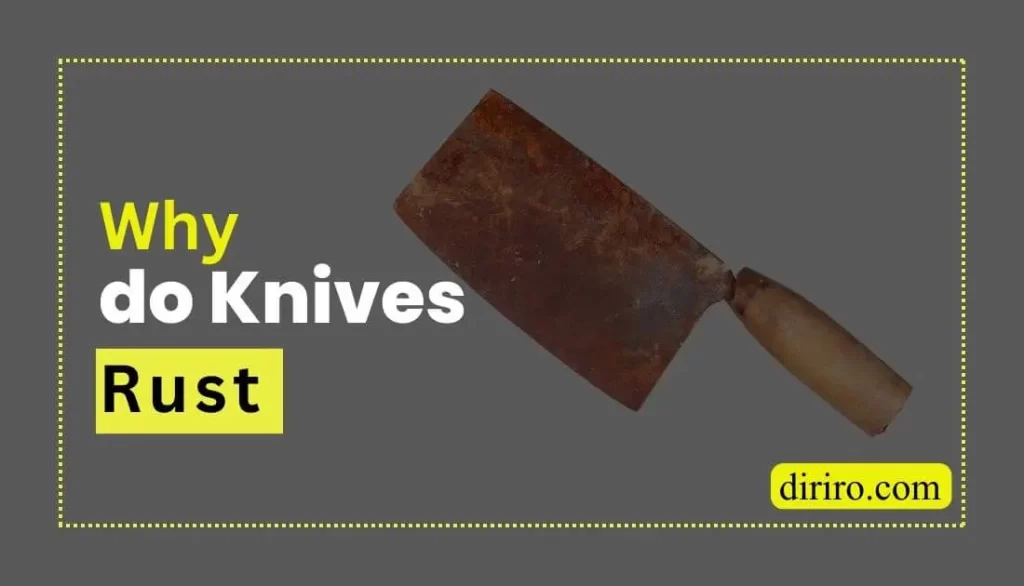Chances are you have encountered a nasty surprise with your knives after leaving them out in the rain, after soaking them in water, or even if you found them in an old toolbox you hadn’t opened for quite some time.
Almost two centuries ago, rust on a knife was sometimes considered a sign of the quality of the knife – a sign that it had made it long enough to warrant a sign of rust. I know it may be ugly, but rusty knives are not just unsightly, they are also dangerous and useless.
Let’s ask ourselves one question first: why does kitchen equipment rust?
What is Rust?
Iron oxide, or rust, is a compound composed of iron and oxygen. On the surface of the metal, you can see a sort of flaky red/orange substance that grows. This oxide is formed when iron reacts with oxygen when exposed to moisture. In addition to that, there doesn’t even have to be any liquid in the air for your kitchen knives to rust, even if there is a little moisture in the air.
Blades of your kitchen knives contain iron, which is the secret ingredient. It is important to note that rusting happens as a result of the iron in your knives being exposed to oxygen and moisture.
Stainless steel blades are a good alternative, but how about they are made of plastic?
Stain resistance is more of a characteristic of stainless steel, rather than stain-proofness. It still contains at least 10.5% of chromium so it is still deemed steel as it contains at least 10% of chromium. The stainless steel material that is available nowadays has an extra protective layer that enables it to have the characteristics of being ‘stain-less’ but not ‘stain-free’.
How to Remove Rust from Your Knife
It is time for us to delve into the different methods that may help you remove rust from your knives and to get them back to their former glory. After learning exactly what rust is and how it starts, it is time to begin learning how to remove this nasty substance.
All of the above methods can be used repeatedly over a period of time to clean blades that have been exposed to a lot of rust. Remember, though, to ensure a safe and sharp blade, make sure you resharpen your kitchen knife afterward.
1. Baking Soda
If you have knives with light rust stains or thin metal items, baking soda is an excellent cleaner.
It is imperative that you wipe the knife down and clean it thoroughly before beginning the rust removal process so that no dirt will interfere with the process. In order to remove dirt, clean the blade with a cleaning solution and wipe it down with a cloth, avoiding spraying water as moisture was meant to cause the blade to rust in the first place.
Make a thick paste by mixing baking soda and water and spreading it over all rusted areas of the metal. Leave the paste to sit for about an hour, as long as the metal has not begun to rust.
Scrub away the rusted areas using a toothbrush. Steel wool or a slightly abrasive sponge works well in dealing with extremely rusted knives, but remember to avoid excessive pressure to prevent damage.
Afterward, you should use water to wash off the paste and a cloth to dry it thoroughly. It is recommended that whenever possible you apply a lightweight mineral oil such as camellia oil to your kitchen knife to help protect it from rust and to keep it lubricated.
2. Vinegar Method
Rust is attacked by acetic acid, found in white vinegar. Don’t use vinegar with other colors as they may leave stains.
Five minutes is about right for soaking your knife in white vinegar. Too much time will damage your knife.
In the event some rust is still present after five minutes, a baking soda solution will remove any remaining rust. To keep your blades rust-proof in the future, we recommend lubricating them with camellia oil.
The vinegar should be washed off with water and wiped and dried with a cloth.
3. Lemon and Salt
Lemon juice mixed with salt can be used to remove small spots of rust.
Use lemon juice to saturate the rusted areas of your blade with salt. After two hours, you can use them again.
After that, use lemon rind to scrub the affected areas. If you need an even more abrasive product, you may wish to use steel wool or a wire brush.
Remove the blade from the blade with water and wipe it dry.
4. Potato Method
In spite of its oxalic acid content, potatoes are one of the most surprisingly effective methods of removing rust.
To peel potatoes, stick your knife into them for a few minutes and let them dry. The rust should disappear after you remove the blade and wipe it down with oil after removing it.
5. Onion Method
Natural ways of derusting blades include eating foods that remove rust. While cutting onions, slide the blade from side to side to remove the rust on it.
Sulfenic acid is one of the ingredients that give your kitchen knives a good clean after cutting onions. It is notorious for making adults cry while cutting onions.
In case of failure, Grab a new knife!
It’s okay to let your knife go if the knife is beyond repair or if you aren’t willing to put the time and effort into removing the rust. Or if you still don’t know why do knives rust then check best kitchen knife set under $300.
We carry top-of-the-line knives from world-renowned brands. All of these come with manufacturer warranties and guarantees, so you can enjoy your knives for many years.
